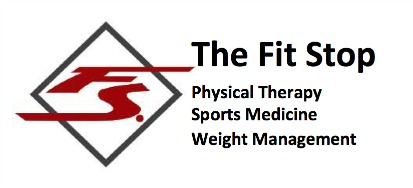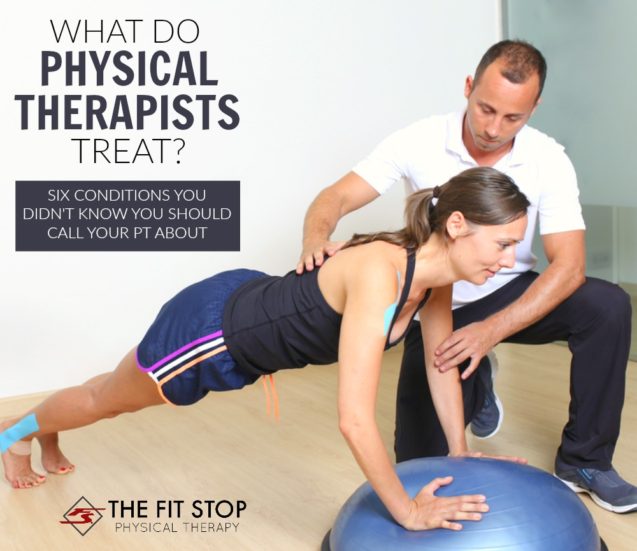What Do Physical Therapists Treat
When you think of a “physical therapy patient” what comes to your mind? I’ll bet that for most people it’s someone who just had surgery and is rehabilitating their knee or shoulder. While it’s true that many conditions we treat are following surgery, did you know that the majority of our patients never set foot in an operating room?! Today on the Fit Stop Blog, Jared Beckstrand, PT, DPT, is discussing some of other common conditions we treat as physical therapists – some that you may not even know we treat! Keep reading for more…
 Lower Back Pain – Lumbar pain is the most-common condition treated in physical therapy. In fact, did you know that 8 out of 10 people will experience some form of low back pain at some point in their life? Whether you “tweaked” your back doing yard work over the weekend or the pain has been there “for years”, physical therapists are trained specialists in identifying and diagnosing where your pain is coming from and then prescribing exercises that will help you feel better. For more information on low back pain, here are some links that you might find helpful: “When Should I See Someone About My Back Pain?” “10 Great Exercises For Low Back Pain” “5 Of The Best Stretches For Low Back Pain”
Lower Back Pain – Lumbar pain is the most-common condition treated in physical therapy. In fact, did you know that 8 out of 10 people will experience some form of low back pain at some point in their life? Whether you “tweaked” your back doing yard work over the weekend or the pain has been there “for years”, physical therapists are trained specialists in identifying and diagnosing where your pain is coming from and then prescribing exercises that will help you feel better. For more information on low back pain, here are some links that you might find helpful: “When Should I See Someone About My Back Pain?” “10 Great Exercises For Low Back Pain” “5 Of The Best Stretches For Low Back Pain”
Sciatica – In it’s simplest terms, sciatica is defined as nerve pain that runs down the back of your leg. The pain usually originates up in your butt/lower back and runs down your leg like electricity. Sometimes it’s dependent on certain motions/activities; in more sever cases it can be constant. While it’s one thing to know what sciatica is, it’s certainly another to know why it’s there. Sciatica can be caused by things like space and alignment in your spine all the way down to tightness in your hips. Physical therapists are trained professionals in identifying where your symptoms are coming from and then addressing these issues.
 Neck Pain and Headaches – With all the advancements in technology these days neck pain is becoming more and more of an issue. Let’s face it – we’re spending a lot more time on our computers and devices. This usually results in poor posture that we end up sustaining for extended periods of time. This can cause undo stress through your neck and upper shoulders which, if left unchecked, can result in chronic pain/tension and even headaches. Physical therapists use massage and stretching to decrease your pain and symptoms and then recommend exercises to strengthen your postural muscles that will hold you in better alignment. Read more about it here: “What Can Physical Therapy Do For My Neck Pain?” “5 Ergonomic Changes To Help Your Neck Pain” “6 Exercises To Eliminate Neck Pain And Tension”
Neck Pain and Headaches – With all the advancements in technology these days neck pain is becoming more and more of an issue. Let’s face it – we’re spending a lot more time on our computers and devices. This usually results in poor posture that we end up sustaining for extended periods of time. This can cause undo stress through your neck and upper shoulders which, if left unchecked, can result in chronic pain/tension and even headaches. Physical therapists use massage and stretching to decrease your pain and symptoms and then recommend exercises to strengthen your postural muscles that will hold you in better alignment. Read more about it here: “What Can Physical Therapy Do For My Neck Pain?” “5 Ergonomic Changes To Help Your Neck Pain” “6 Exercises To Eliminate Neck Pain And Tension”
Shoulder Pain – Your shoulder is the most mobile joint in your entire body. As such it undergoes quite a bit of wear-and-tear… especially as we get older. Whether it be a rotator cuff, a tendonitis, or even an overuse injury from lifting, there are a lot of tissue in and around the shoulder that are susceptible to injury. One of the key components to rehabbing shoulder pain is being able to identify exactly which of these structures is affected and prescribing the best treatment to help them recover. Physical therapists are specially trained in identifying these conditions and then helping them achieve maximum recovery. Read some of our other posts for more information about shoulder pain: “How To Treat A Rotator Cuff Tear” “5 Simple Fixes For Shoulder Tendonitis” “Best Shoulder Warm Up Before Exercising”
 Knee Pain – From arthritis symptoms to runner’s knee, knee pain can be limiting, debilitating, and otherwise just miserable. Many people think of physical therapy as treating post-operative knee pain, but did you know there’s a lot that can be done to actually help you to avoid going under the knife in the first place? Strengthening the supporting structures in and around your knee joint not only add a great deal of stability to this area, but can help decrease pain and inflammation as well. For more information about your knee pain see: “6 Tips To Keep Your Knees Healthy” “Best Exercises for Patellofemoral Pain” “Can Physical Therapy Help Me Before Knee Surgery?”
Knee Pain – From arthritis symptoms to runner’s knee, knee pain can be limiting, debilitating, and otherwise just miserable. Many people think of physical therapy as treating post-operative knee pain, but did you know there’s a lot that can be done to actually help you to avoid going under the knife in the first place? Strengthening the supporting structures in and around your knee joint not only add a great deal of stability to this area, but can help decrease pain and inflammation as well. For more information about your knee pain see: “6 Tips To Keep Your Knees Healthy” “Best Exercises for Patellofemoral Pain” “Can Physical Therapy Help Me Before Knee Surgery?”
Whatever your condition may be, you’ll be amazed at what the right form of exercise can do for you. Whether it’s stretching where is tight, strengthening where is weak, or a combination of both, physical therapists are experts at treating most musculoskeletal conditions.
If you have a pain that’s been bothering you please give us a call! We would love to offer you a free assessment to discuss your pain and evaluate whether or not physical therapy is right for you. Click on one of the links below to contact us at one of our four conveniently-located locations:
Heber City Salt Lake Farmington Murray
Fit Stop Physical Therapy – Farmington
172 N East Promontory Ste 200
Farmington, UT 84025
(435) 654 – 5607


